Understanding how to effectively integrate your logo into custom work shirts fosters a professional look and makes your brand easily identifiable. A well-placed logo exudes brand identity and maintains your company’s branding. The key is to strike a balance between visibility and delicacy, ensuring that your logo enhances the design without overwhelming it.
At ooShirts, we excel in strategically placing your logos. Whether you’re outfitting a team or customizing event shirts, our expertise ensures your logo is both stylish and perfectly crafted. Our team provides personalized guidance to help you choose the perfect placement and size for your logo, which enhances the shirt’s design and gives more presence to your brand.
In our commitment to quality with attention to detail, we’ve put together this guide to integrate your logo into your custom work shirts. We’ll lead you through everything you need to know, from choosing the right type of shirt to placement that offers maximum branding impact. You’ll be empowered to make effective decisions for your brand and leave a lasting impression.
Let’s get started!
How to Incorporate Your Logo into Custom Work Shirts?
Putting your logo on custom work shirts is a powerful way to increase brand awareness and add a professional touch. The process involves selecting the proper placement and colors, collaborating with a designer, and finalizing your order. Follow these steps to ensure your custom shirts perfectly reflect your brand:
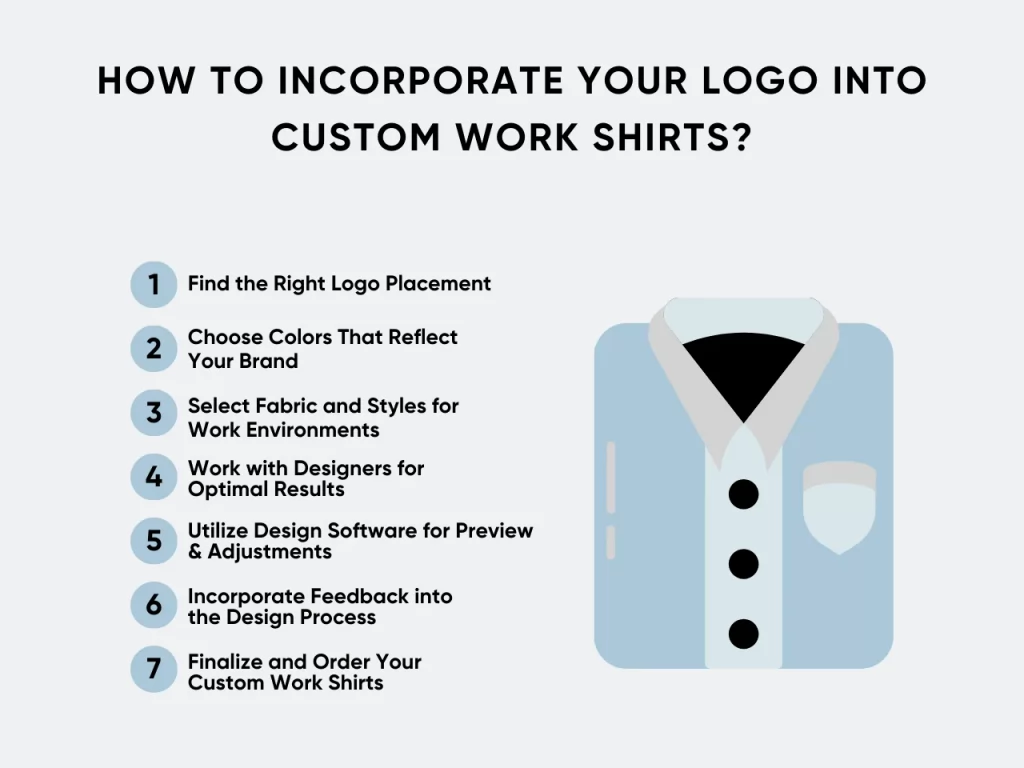
Step 1: Identify the Right Placement for Your Logo
Choosing the right location for a logo on custom work shirts can differentiate between a good and a great impression. It not only determines the overall look of the shirt but also influences how others perceive a brand. Consider these tips to ensure your logo placement is just proper:
- Logo Size and Design: For more prominent logos, the back or sleeves are ideal. Smaller logos, however, fit perfectly on the left or right chest.
- Visibility and Impact: Consider how prominently you want your logo displayed. Placing it on the left chest offers a subtle, professional touch. The back provides a larger canvas if you make a bold statement.
- T-Shirt Design and Seams: Be aware of the shirt’s design and seams. The logo’s Intelligent Placement leaves it looking great and is not distorted by the shirt’s structure.
- Branding Goals: Match the logo placement with your branding goals. For high visibility, go for a larger area like the back. For a more understated look, the left chest is a classic choice.
- Consistency with Other Apparel: If these shirts are part of a more oversized uniform or branding strategy, keep the logo placement consistent with other branded items. This creates a unified and professional look.
Step 2: Choose Colors That Reflect Your Brand and Stand Out
Choosing work shirt colors will help you develop a robust design that reflects your brand. Begin with the colors that most closely match your brand’s guidelines and are easily recognizable. The right colors should connect with your brand identity and be noticeable on the fabric.
When picking colors, consider the work environment and job type. Bold and bright hues might be perfect for a creative agency. However, muted and sophisticated colors are usually more appropriate in a formal business setting. Experiment with different color combinations and check the contrast levels to ensure that the logo and design stand out and are easy to see.
Step 3: Select Fabric and Shirt Styles for Different Work Environments
Choosing the suitable fabric and shirt style is essential for comfort and professionalism. The demands of your work environment should guide your selection, ensuring you’re dressed appropriately for the tasks at hand. Follow these tips to help you choose the best options for your needs:
- Physically Demanding Jobs: Choose sturdy fabrics, preferably cotton shirts or cotton-blend fabric, that provide comfort and breathability.
- Office Settings: For a professional appearance, opt for long sleeve button-down oxfords or short sleeve polos made from cotton twill or high-performance fabrics. Consider different styles, such as performance shirts, to match its purpose.
- Warm Weather: Use light weaves with natural fibers, preferably linen or moisture-wicking materials, to keep your shirts cool. Consider tank tops as a cooler option on the hottest days.
- Cold Weather: For warmth and comfort, opt for heavier fabrics like flannel or fleece. Consider layering it with zip-up hoodies or sweatshirts as outerwear to protect it against the cold.
Step 4: Work with Professional Designers for Optimal Results
Working with professional designers will help you ensure your custom work shirts look their best. Platforms like ooShirts offer expert custom shirt printing services to bring your vision to life. Their expertise ensures your design looks pretty and is styled perfectly to fit your brand. Uncover these benefits to elevate your design:
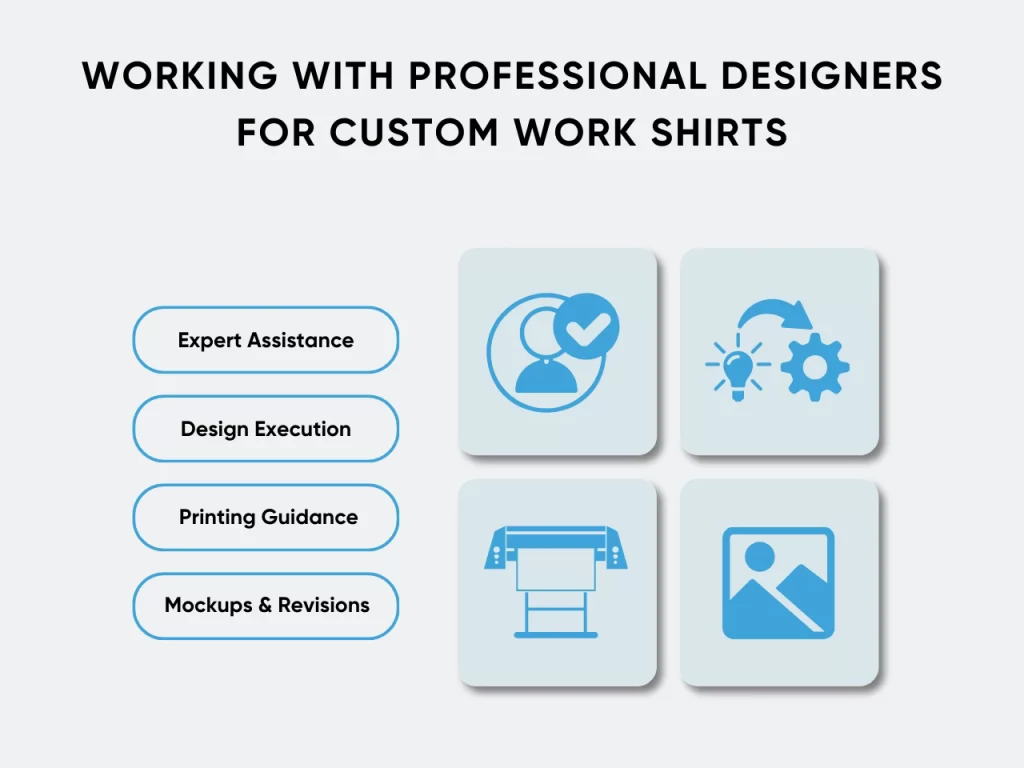
- Expert Assistance: Professional designers bring expertise, ensuring your own design looks great and functions perfectly. They know design principles inside and out, paying meticulous attention to detail to boost your design’s overall quality.
- Design Execution: Designers craft your ideas into a sleek, polished design. They work from including your logo to choosing the right fonts and color palettes, ensuring everything aligns with your brand’s identity.
- Printing Guidance: Based on their experience, designers may suggest suitable printing methods for your design. This guidance ensures that your final apparel, including performance shirts, looks fantastic and withstands wear and tear.
- Mockups and Revisions: Designers provide mockups and handle revisions, letting you see different versions of your design. This process helps you adjust to ensure the final product suits your needs and style.
Step 5: Utilize Design Software for Preview and Adjustments
Design software lets you visualize your logo’s appearance on custom work shirts. Design tools like the ooShirts Design App allow you to experiment with different design elements and make necessary adjustments before finalizing your order.
Check out these key features of design software to enhance your design process:
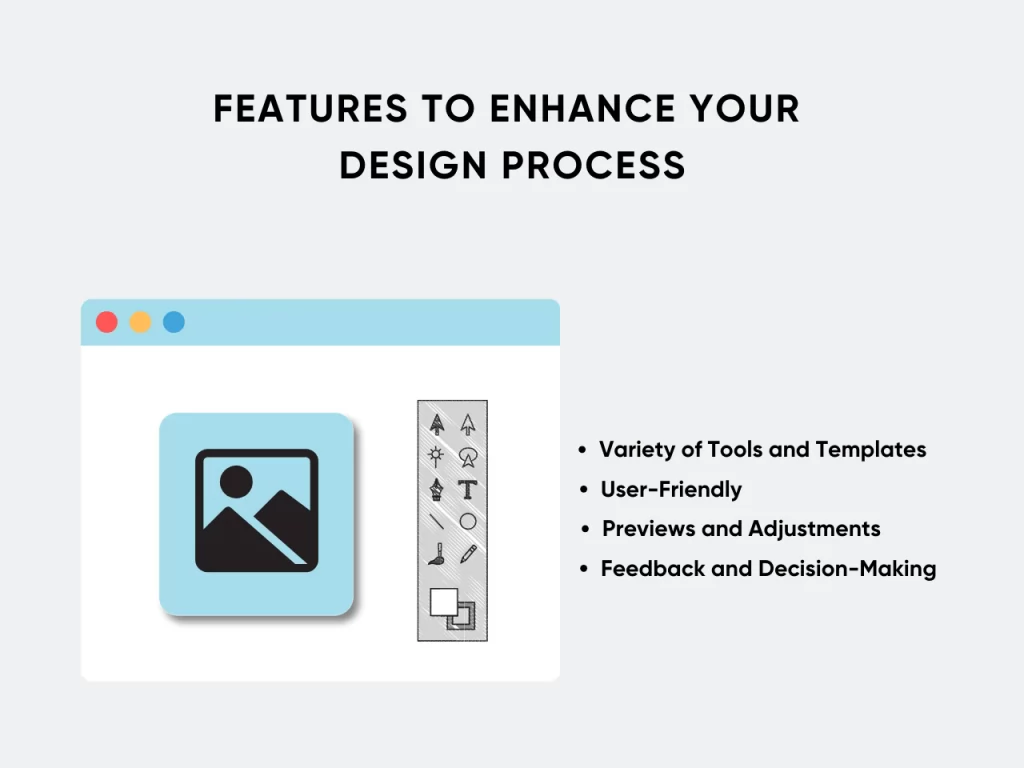
- Variety of Tools and Templates: Design software and online tools offer a wealth of templates and design elements, letting you tailor your workwear design, including performance polos, to fit your brand perfectly.
- User-Friendly: Such tools are easy to use and user-friendly, so even a non-design pro can use them. You can easily play around with logo placement, color, and fonts.
- Previews and Adjustments: The design can be previewed before the final output, which is great for minor kinks and adjustments to finalize your order.
- Feedback and Decision-Making: Previewing makes it possible to gather feedback from others regarding the design, comfortability, and durability that best match your goals.
Step 6: Incorporate Feedback Into the Design Process
Design and conceptualize your company’s custom work shirt using design software and online tools that provide templates and design elements. They are easy to use, so you can easily play around with logos, colors, and font style configurations, even if you have minimal design experience. You can customize and see a design preview before incurring production costs.
Seeing a visual representation of your design is incredibly useful for gathering feedback and making final decisions. It lets you fine-tune your design and ensure it meets your needs perfectly before committing to the final product.
Step 7: Finalize and Order Your Custom Work Shirts
Once you’re satisfied with the design, double-check everything for accuracy. Seeing a visual representation of your design is very helpful for gathering feedback, especially when considering business attire. You can tune the design to your needs before committing to the final product.
Consider the delivery factors and quantities to ensure your custom work shirts meet your expectations. Look into quantity discounts offered by your supplier to save on larger orders. Also, check the supplier’s return and exchange policies to handle any sizing inconsistencies or minor defects. Having a straightforward resolution process ensures you receive high-quality shirts for your team.
Printing Technologies and Embroidery Techniques for Custom Work Shirts Logo
When it comes to customizing apparel, understanding the different printing and embroidery techniques is critical to achieving the perfect look for your project. Each method has strengths and limitations, making it suitable for various designs and fabrics. Explore the ins and outs of screen printing, digital printing, and embroidery to help you decide which technique best suits your needs.
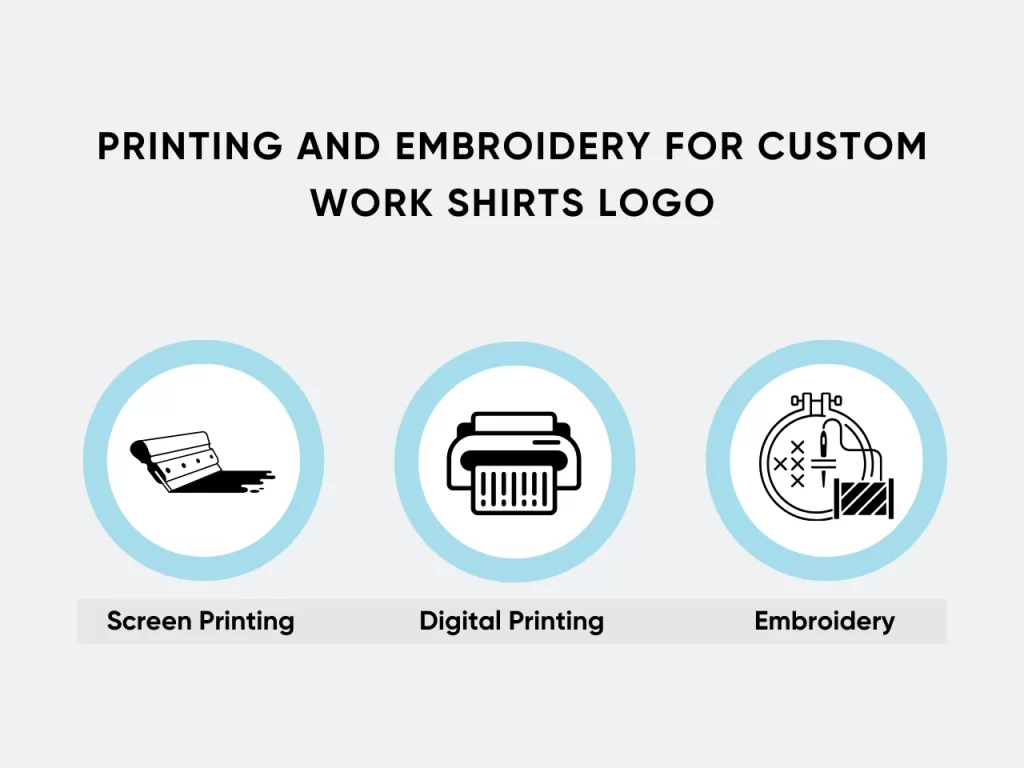
Screen Printing
Screen printing is one of the in-demand methods for loud, bright designs that make a dent. It’s incredibly cost-effective when printing in bulk—most budget-friendly the more you print. This versatile practice works well on various fabrics and is perfect for everything from T-shirts to tote bags.
That said, however, screen printing has its limitations, particularly with intricate designs. Fine details and gradients can be tricky to achieve, so there might be better fits for complex artwork. The setup process also takes time, making it less suitable for smaller orders where time and cost efficiency are critical. Overall, it’s an excellent option for large runs but can be costly for smaller batches.
Digital Printing
Digital printing is ideal for a full-color image with high detail. The significant advantage is that it turns around swiftly with virtually no setup time, perfect for smaller orders or when you’re in a rush. There are no color limitations, so you’re free to throw all your colorful hues and gradients within your design.
However, digital printing can be more expensive for large orders than screen printing. Durability is another consideration, as digital prints may fade faster with frequent washing, especially on darker fabrics. It also works mainly on certain kinds of fabric, specifically lighter ones, which could limit its usefulness depending on your project.
Embroidery
Embroidery sharpens logos by adding texture and dimension, giving them a clean and sophisticated appearance. Embroidered designs are ruggedly durable, quickly standing up to wear and abrasion yet looking freshly new over time; perfect for uniforms, hats, and jackets.
Those looking for large or intricate designs can find embroidery costlier. It’s not ideal for detailed or small text, as the stitching can only go fine. Additionally, embroidery works best on thicker fabrics; thinner or stretchier materials might not hold up, which could limit your options depending on the garment.
Tips for Handling Legal Considerations in Your Custom Work Shirts Logo
Handling the legal minefield involved in putting your logo onto custom work shirts is critical to protecting your brand and ensuring the smooth operation of your business. Ensure to adhere to several key areas, such as copyright laws, ownership rights, industry standards, and potential pitfalls. Here’s a comprehensive guide to managing these legal considerations effectively:
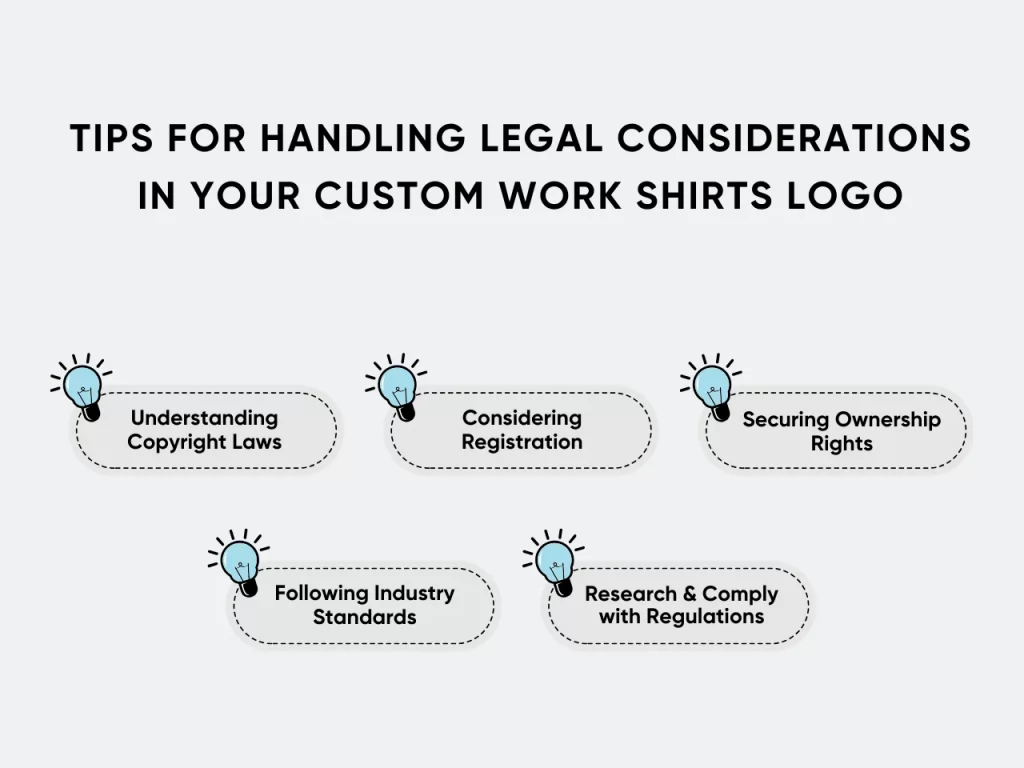
1. Understanding Copyright Laws
Copyright laws for logos on custom work shirts protect your company’s brand identity and intellectual property. It ensures your logo is used correctly and avoids infringement. You should establish the ownership rights for your logo design to prevent future conflicts. Consider registering the copyright to add more protection and legal support if required.
Ensuring, as far as possible, that your brand has not infringed on any industry standards or regulations lessens risks and helps protect your brand’s integrity. Researching copyright laws protects your brand and shows that you value the interests of real people who interact with and see your brand.
2. Considering Company Registration
Registering your company logo is a critical aspect of protecting your brand. This registers the full usage rights exclusively to you at the time of your registration and lays down a solid base on which to take legal action if there is any infringement against your design. Learn about these essential advantages to help strengthen your business image:
- Benefits of Registration: Registering your logo has legal benefits for the owner. It gives the right to use that particular design solely if he wants to dispute any issues in court.
- Brand Credibility: A registered logo enhances your brand’s credibility and prevents others from using it without authorization.
- Compliance: Proper research backed by guidelines prescribed for registration in specific states will secure your intellectual property and maintain the integrity of your brand.
3. Securing Ownership Rights
Registering your logo secures ownership rights and gives you control over your brand’s identity. It ensures exclusivity, preventing unauthorized use by other companies. Explore these key benefits to solidify your brand’s position.

- Exclusive Ownership: Make sure your business exclusively owns your logo and design. This keeps others from using or reproducing your logo without permission.
- Legal Protection: Having rights to your logo grants one powerful legal protection against any infringement, which works wonders in protecting brand identity.
- Freedom of Use: As an owner, you can use your logo on various merchandise without legal hassles.
- Integrity and Exclusiveness: Clear ownership from the beginning can enhance your brand and guarantee that your custom work shirts will be made with integrity and exclusivity.
4. Following Industry Standards
Adhering to industry standards with customized work shirts keeps your logo aligned with the regulatory standards. This increases professionalism in your work apparel and, at the same time, guards your brand image by showing you are committed to quality and compliance.
Staying informed about updates or regulation changes is critical to maintaining a consistent and legally compliant logo presence on your custom work shirts. Researching and complying with these standards reflects your dedication to upholding high standards and keeping your brand in line with industry expectations.
5. Researching and Complying with Regulations
Researching and complying with regulations when adding your logo to custom work shirts is essential for legal and ethical reasons. Understanding copyright laws ensures you can use your logo while securing ownership rights and protecting it from unauthorized reproduction. Registering your logo can further formalize its legal protection, giving you added security.
Following industry standards helps maintain quality and consistency in your custom work shirts. You avoid potential legal issues and confidently showcase your brand by staying informed about and adhering to relevant regulations. This approach keeps you within legal boundaries and reinforces your commitment to professionalism and quality.
Key Takeaway
Integrating your logo into custom work shirts enhances your brand’s visibility and ensures a polished look. Getting the placement and size right is crucial for making a solid impression. Typical placements include the left chest, center chest, or across the back. Each option provides a different level of visibility, so choose based on how prominently you want your logo to stand out.
Selecting high-quality shirts is also essential to effectively showcase your logo. Durable fabrics and precise craftsmanship ensure your logo looks sharp and remains vibrant after repeated washes. The fitting shirt highlights your logo and offers comfort and longevity for the wearer, making it a wise investment for your team.
Ready to make your brand stand out? Contact us at [email protected] for personalized guidance on logo placement or selecting the perfect shirts for your needs. You can also visit our ooShirts blog page for more insights and tips on custom work shirts and logo integration. Let’s work together to ensure your branding shines and your team looks professional!
